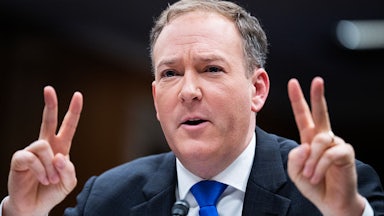The Trump administration hasn’t been great for the oil industry. In its quest to “drill, baby, drill” and expand trade wars, the White House has also sent fuel prices tumbling and brought about what could be the industry’s most tumultuous period since the onset of the Covid-19 pandemic. Although the prospect of lower gas prices might hold some populist appeal, cheap oil is potentially disastrous for the companies responsible for actually getting those products to the pump; drilling here is expensive, and low prices mean that many firms could struggle to break even. Tariffs are making it more expensive to build and maintain rigs, while the general chaos of Trumponomics 2.0 threatens to bring about a recession that would crater already sluggish demand. A new report from the energy consultancy Wood McKenzie notes that if prices fall below $50 per barrel, domestic production could decline by up to 1.2 million barrels per day by 2026. The International Energy Agency has slashed its forecast for oil demand growth by nearly a third since last month and projects oil supply will outstrip demand by the greatest amount since 2020.
Despite oil and gas executives’ blistering criticism of Trump’s policies, the White House seems determined to stay the course. Few have been more enthusiastic about that project than Interior Secretary Doug Burgum. This week, he announced plans to loosen rules on the types of drilling companies can do in the Gulf, overhaul federal leasing, and open up new areas for oil and gas extraction, in line with Trump’s move to reverse Biden administration bans on drilling in parts of the Pacific and Alaska. The Department will further implement “emergency permitting procedures” to fast-track leasing, production, transportation, and refining for oil, gas, coal, and several other commodities. A draft strategic plan obtained by journalists at the investigative Substack outlet Public Domain outlines plans to “treat national resources as national assets,” prioritizing oil and gas development and peeling back regulations. With the help of the Department of Government Efficiency and longtime oilman Tyler Hassen—now serving as assistant secretary of policy management and budget, or AS-PMB—Burgum is planning on “unifying and consolidating” key departmental functions. The ultimate goal is to create “significant efficiencies across the Department by improving processes, eliminating redundant efforts, and helping integrate technology adoption.” Mass layoffs are expected to begin early next month.
Many of these plans, though, seem bizarrely out of touch with what the industry seems to actually want. Take Burgum’s plan to expand drilling in the Gulf. Verite News reporter Tristan Baurick notes that only a fifth of active drilling leases there are currently producing oil, per Bureau of Ocean Energy Management records. Given gloomy price and demand projections, how will selling off more of those leases spur production? “It’s not the regulations that are getting in the way, it’s the economics,” Hugh Daigle, a professor of petroleum engineering at the University of Texas in Austin, told Baurick. “It’s true that there are a bunch of undeveloped leases in the Gulf, and it’ll stay that way if we continue to see low or stagnant oil prices.”
Shares in the oilfield services firm Halliburton plummeted earlier this week as company executives warned about the impact of tariffs and lower oilfield activity on its bottom line. Halliburton Chief Executive Jeff Miller said, on a quarterly earnings call with investor analysts, that customers in North America are “are in the midst of evaluating their activity scenarios, and plans for 2025 activity reductions could mean higher than normal white space for committed fleets and in some cases, the retirement or export of fleets to international markets.” (White spaces refer to periods when the company’s equipment isn’t booked for use.)
One oil and gas executive put it more bluntly, responding to the Federal Reserve Bank of Dallas’s anonymized quarterly survey of the industry, released late last month. “There cannot be ‘U.S. energy dominance’ and $50 per barrel oil; those two statements are contradictory,” the executive wrote. “At $50-per-barrel oil, we will see U.S. oil production start to decline immediately and likely significantly.”
For as long as it’s existed, the U.S. oil and gas industry has depended upon a complex array of government support that reaches well beyond long-standing tax breaks. Over the last century, executives have routinely relied on local, state, and federal officials to stabilize prices, fund basic research, and open up markets for their products abroad. The Department of Interior plays an important part in that. The federal government, that is, provides a long view that industry insiders chasing short-term returns tend to lack. As Burgum and his colleagues in Trump’s Cabinet take a chain saw to supposed government waste, they risk kneecapping the bureaucracies that help keep his favorite industry afloat.
The White House’s ideological crusades, in other words—to downsize government, tear up regulations, and get as many fossil fuels out of the ground as possible—are increasingly divorced from the interests of the industry it claims to be defending. Despite being stocked with and paid for by oil and gas executives, the Trump administration might end up doing more damage to America’s fossil fuel industry than Democrats’ alleged “Green New Scam” ever dreamed of.








